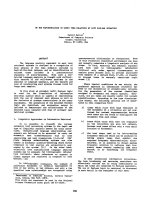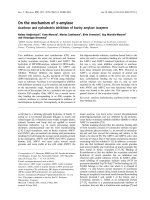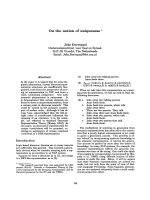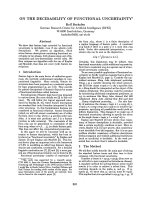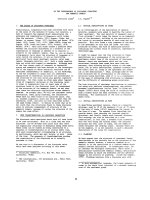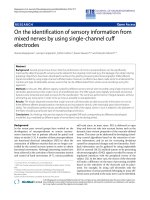Báo cáo hóa học: "ON THE SYSTEM OF RATIONAL DIFFERENCE EQUATIONS xn+1 = f (yn−q ,xn−s ), yn+1 = g(xn−t , yn− p )" ppt
Bạn đang xem bản rút gọn của tài liệu. Xem và tải ngay bản đầy đủ của tài liệu tại đây (489.82 KB, 8 trang )
ON THE SYSTEM OF RATIONAL DIFFERENCE EQUATIONS
x
n+1
= f (y
n−q
,x
n−s
), y
n+1
= g(x
n−t
, y
n−p
)
TAIXIANG SUN AND HONGJIAN XI
Received 20 March 2006; Revised 19 May 2006; Accepted 28 May 2006
We study the global behavior of positive solutions of the system of r ational difference
equations x
n+1
= f (y
n−q
,x
n−s
), y
n+1
= g(x
n−t
, y
n−p
), n = 0,1,2, ,wherep,q,s, t ∈
{
0,1,2, } with s ≥ t and p ≥ q, the initial values x
−s
,x
−s+1
, ,x
0
, y
−p
, y
−p+1
, , y
0
∈
(0,+∞). We give sufficient conditions under which every positive solution of this system
converges to the unique positive equilibrium.
Copyright © 2006 T. Sun and H. Xi. This is an open access article distributed under the
Creative Commons Attribution License, which permits unrestricted use, distribution,
and reproduction in any medium, provided the original work is properly cited.
1. Introduction
In this paper, we study the convergence of positive solutions of a system of rational dif-
ference equations. Recently there has been published quite a lot of works concerning the
behavior of positive solutions of systems of rational difference equations [1–7, 9, 11]. Not
only these results are valuable in their own right, but also they can provide insight into
their differential counterparts.
Papaschinopoulos and Schinas [10] studied the oscillatory behavior, the periodicity,
and the asymptotic behavior of the positive solutions of systems of rational difference
equations
x
n+1
= A +
x
n−1
y
n
, y
n+1
= A +
y
n−1
x
n
, n = 0,1, ,
(1.1)
where A
∈ (0,+∞) and the initial values x
−1
,x
0
, y
−1
, y
0
∈ (0,+∞).
Recently, Kulenovi
´
candNurkanovi
´
c[8] investigated the global asymptotic behavior
of solutions of systems of rational difference equations
x
n+1
=
a + x
n
b + y
n
, y
n+1
=
d + y
n
e + x
n
, n = 0,1, ,
(1.2)
where a, b,d,e
∈ (0,+∞) and the initial values x
0
, y
0
∈ (0,+∞).
Hindawi Publishing Corporation
Advances in Difference Equations
Volume 2006, Article ID 51520, Pages 1–8
DOI 10.1155/ADE/2006/51520
2 The system of difference equations
In this paper, we consider the more general equation
x
n+1
= f
y
n−q
,x
n−s
, y
n+1
= g
x
n−t
, y
n−p
,
(1.3)
where p,q,s,t
∈{0,1,2, } with s ≥ t and p ≥ q, the initial values x
−s
,x
−s+1
, ,x
0
, y
−p
,
y
−p+1
, , y
0
∈ (0,+∞)and f satisfies the following hypotheses.
(H
1
) f (u,v),g(u,v) ∈ C(E × E,(0,+∞)) with a = inf
(u,v)∈E×E
f (u,v) ∈ E and b =
inf
(u,v)∈E×E
g(u,v) ∈ E,whereE ∈{(0,+∞),[0,+∞)}.
(H
2
) f (u,v)andg(u,v) are decreasing in u and increasing in v.
(H
3
) Equation
x
= f (y,x), y = g(x, y)
(1.4)
has a unique positive solution x
= x, y = y.
(H
4
) f (b,x) has only one fixed point in the interval (a,+∞), denoted by A,andg(a, y)
has only one fixed point in the interval (b,+
∞), denoted by B.
(H
5
)Foreveryw ∈ E, f (w,x)/x and g(w,x)/x are nonincreasing in x in (0,+∞).
2. Main results
Theorem 2.1. Assume that (H
1
)–(H
5
)holdand{(x
n
, y
n
)} is a positive solution of (1.3),
then there exists a positive integer N such that
f (B,a)
≤ x
n
≤ A, g(A,b) ≤ y
n
≤ B, for n ≥ N.
(2.1)
Proof. Since a
= inf
(u,v)∈E×E
f (u,v) ∈ E and b = inf
(u,v)∈E×E
g(u,v) ∈ E,wehave
x = f (y,x) >f(y +1,x) ≥ a,
y = g(x, y) >g(x +1,y) ≥ b.
(2.2)
Claim 1. g(A,b) <
y<Band f (B,a) < x<A.
Proof of Claim 1. If B
≤ y, then it follows from (H
2
), (H
4
), and (H
5
)that
B
= g(a,B) >g(x,B) = B
g(
x, B)
B
≥ B
g(
x, y)
y
= B, (2.3)
which is a contradiction. Therefore
y<B. In a similar fashion it is true that x<A.
Since
y<Band x<A,wehavethat
f (B,a) <f(
y
,
x
)
=
x
, g(A,b) <g(
x
,
y
)
=
y
,
(2.4)
Claim 1 is proven.
Claim 2. (i) For all n ≥ q +1,x
n+1
≤ x
n−s
if x
n−s
>Aand x
n+1
≤ A if x
n−s
≤ A.
(ii) For all n
≥ t +1, y
n+1
≤ y
n−p
if y
n−p
>Band y
n+1
≤ B if y
n−p
≤ B.
T. Sun and H. Xi 3
Proof of Claim 2. We only prove (i) (the proof of (ii) is similar). Obviously
x
n+1
= f
y
n−q
,x
n−s
≤
f
b,x
n−s
. (2.5)
If x
n−s
≤ A,thenx
n+1
≤ f (b,x
n−s
) ≤ f (b,A) = A.
If x
n−s
>A,then
f
b,x
n−s
x
n−s
≤
f (b,A)
A
= 1, (2.6)
which implies x
n+1
≤ f (b,x
n−s
) ≤ x
n−s
. Claim 2 is proven.
Claim 3. (i) There exists a positive integer N
1
such that x
n
≤ A for all n ≥ N
1
.
(ii) There exists a positive integer N
2
such that y
n
≤ B for all n ≥ N
2
.
Proof of Claim 3. We only prove (i) (the proof of (ii) is similar). Assume on the contrary
that Claim 3 does not hold. Then it follows from Claim 2 that there exists a positive in-
teger R such that x
n(s+1)+R
≥ x
(n+1)(s+1)+R
>Afor every n ≥ 1. Let lim
n→∞
x
n(s+1)+R
= A
1
,
then A
1
≥ A.
We k now f rom Claim 2 that
{x
n
} and {y
n
} are bounded. Let c= lim
n→∞
sup y
n(s+1)+R−q−1
,
then c
≥ b and there exists a sequence n
k
→∞such that
lim
k→∞
y
n
k
(s+1)+R−q−1
= c. (2.7)
By (1.3)wehavethat
x
n
k
(s+1)+R
= f
y
n
k
(s+1)+R−q−1
,x
(n
k
−1)(s+1)+R
, (2.8)
from which it follows that
A
1
= f
c,A
1
≤
f
b,A
1
=
A
1
f
b,A
1
A
1
≤ A
1
f (b,A)
A
= A
1
. (2.9)
This with (H
2
)and(H
4
) implies c = b and A
1
= A. Therefore lim
n→∞
y
n(s+1)+R−q−1
= b.
Since
{x
n
} and {y
n
} are bounded, we may assume (by taking a subsequence) that there
exist a sequence l
n
→∞and α,β ∈ E such that
lim
k→∞
x
l
k
(s+1)+R−q−t−2
= α,lim
k→∞
y
l
k
(s+1)+R−q−p−2
= β.
(2.10)
By (1.3)wehavethat
y
l
k
(s+1)+R−q−1
= g
x
l
k
(s+1)+R−q−t−2
, y
l
k
(s+1)+R−q−p−2
, (2.11)
from which it follows that
b
= g(α,β) >g(α +1,β) ≥ b. (2.12)
This is a contradiction. Claim 3 is proven.
4 The system of difference equations
Let N
= max {N
1
,N
2
} +2s +2p,thenforalln>N we have that
x
n
≤ A, y
n
≤ B,
x
n
= f
y
n−q−1
,x
n−s−1
≥
f (B,a),
y
n
= g
x
n−t−1
, y
n−p−1
≥
g(A,b).
(2.13)
Theorem 2.1 is proven.
Theorem 2.2. Let I = [c, d] and J = [α,β] be intervals of real numbers. Assume that f ∈
C(J × I,I) and g ∈ C(I × J,J) satisfy the following properties:
(i) f (u,v) and g(u,v) are decreasing in u and increasing in v;
(ii) if M
1
,m
1
∈ I with m
1
≤ M
1
and M
2
,m
2
∈ J with m
2
≤ M
2
are a solution of the
system
M
1
= f
m
2
,M
1
, m
1
= f
M
2
,m
1
,
M
2
= g
m
1
,M
2
, m
2
= g
M
1
,m
2
,
(2.14)
then M
1
= m
1
and M
2
= m
2
.
Then the system
x
n+1
= f
y
n−q
,x
n−s
, y
n+1
= g
x
n−t
, y
n−p
, n = 0,1, ,
(2.15)
has a unique equilibrium (
S,T) and every solution of (2.15) with the initial values x
−s
,x
−s+1
,
,x
0
∈ I and y
−p
, y
−p+1
, , y
0
∈ J converges to (S,T).
Proof. Let
m
0
1
= c, m
0
2
= α, M
0
1
= d, M
0
2
= β, (2.16)
and for i
= 1,2, ,wedefine
M
i
1
= f
m
i−1
2
,M
i−1
1
, m
i
1
= f
M
i−1
2
,m
i−1
1
,
M
i
2
= g
m
i−1
1
,M
i−1
2
, m
i
2
= g
M
i−1
1
,m
i−1
2
.
(2.17)
It is easy to verify that
m
0
1
≤ m
1
1
= f
M
0
2
,m
0
1
≤
f
m
0
2
,M
0
1
=
M
1
1
≤ M
0
1
,
m
0
2
≤ m
1
2
= g
M
0
1
,m
0
2
≤
g
m
0
1
,M
0
2
=
M
1
2
≤ M
0
2
.
(2.18)
From (i) and (2.18)weobtain
m
1
1
= f
M
0
2
,m
0
1
≤
f
M
1
2
,m
1
1
=
m
2
1
,
m
2
1
= f
M
1
2
,m
1
1
≤
f
m
1
2
,M
1
1
=
M
2
1
,
M
2
1
= f
m
1
2
,M
1
1
≤
f
m
0
2
,M
0
1
=
M
1
1
,
m
1
2
= g
M
0
1
,m
0
2
≤
g
M
1
1
,m
1
2
=
m
2
2
,
m
2
2
= g
M
1
1
,m
1
2
≤
g
m
1
1
,M
1
2
=
M
2
2
,
M
2
2
= g
m
1
1
,M
1
2
≤
g
m
0
1
,M
0
2
=
M
1
2
.
(2.19)
T. Sun and H. Xi 5
By induction it follows that for i
= 0,1, ,
m
i
1
≤ m
i+1
1
≤··· ≤ M
i+1
1
≤ M
i
1
,
m
i
2
≤ m
i+1
2
≤··· ≤ M
i+1
2
≤ M
i
2
.
(2.20)
On the other hand, we have x
n
∈ [m
0
1
,M
0
1
]foranyn ≥−s and y
n
∈ [m
0
2
,M
0
2
]forany
n
≥−p since x
−s
,x
−s+1
, ,x
0
∈ [m
0
1
,M
0
1
]andy
−p
, y
−p+1
, , y
0
∈ [m
0
2
,M
0
2
]. For any n ≥ 0,
we obtain
m
1
1
= f
M
0
2
,m
0
1
≤
x
n+1
= f
y
n−q
,x
n−s
≤
f
m
0
2
,M
0
1
=
M
1
1
,
m
1
2
= g
M
0
1
,m
0
2
≤
y
n+1
= g
x
n−t
, y
n−p
≤
g
m
0
1
,M
0
2
=
M
1
2
.
(2.21)
Let k
= max{s +1,p +1}. It follows that for any n ≥ k,
m
2
1
= f
M
1
2
,m
1
1
≤
x
n+1
= f
y
n−q
,x
n−s
≤
f
m
1
2
,M
1
1
=
M
2
1
,
m
2
2
= g
M
1
1
,m
1
2
≤
y
n+1
= g
x
n−t
, y
n−p
≤
g
m
1
1
,M
1
2
=
M
2
2
.
(2.22)
By induction, for l
= 0,1, , we obtain that for any n ≥ lk,
m
l+1
1
≤ x
n+1
≤ M
l+1
1
, m
l+1
2
≤ y
n+1
≤ M
l+1
2
.
(2.23)
Let
lim
n→∞
m
n
1
= m
1
,lim
n→∞
m
n
2
= m
2
,
lim
n→∞
M
n
1
= M
1
,lim
n→∞
M
n
2
= M
2
.
(2.24)
By the continuity of f and g,wehavefrom(2.17)that
M
1
= f
m
2
,M
1
, M
2
= g
m
1
,M
2
,
m
2
= g
M
1
,m
2
, m
1
= f
M
2
,m
1
.
(2.25)
Using assumption (ii), it follows from (2.23)that
lim
n→∞
x
n
= m
1
= M
1
= S,lim
n→∞
y
n
= m
2
= M
2
= T.
(2.26)
Theorem 2.2 is proven.
Theorem 2.3. If ( H
1
)–(H
5
)holdandthesystem
M
1
= f
m
2
,M
1
, M
2
= g
m
1
,M
2
,
m
2
= g
M
1
,m
2
, m
1
= f
M
2
,m
1
,
(2.27)
6 The system of difference equations
with f (B,a)
≤ m
1
≤ M
1
≤ A and g(A,b) ≤ m
2
≤ M
2
≤ B has the unique solution m
1
=
M
1
= x and m
2
= M
2
= y, then every solution of (1.3) converges to the unique positive equi-
librium (
x, y).
Proof. Let
{(x
n
, y
n
)} is a positive solution of (1.3). By Theorem 2.1, there exists a positive
integer N such that f (B,a)
≤ x
n
= f (y
n−q
,x
n−s
) ≤ A and g(A,b) ≤ y
n
= g(x
n−t
, y
n−p
) ≤
B for all n ≥ N.Since f , g satisfy the conditions (i) and (ii) of Theorem 2.2 in I =
[ f (B, a),A]andJ = [(A,b),B], it follows that {(x
n
, y
n
)} converges to the unique positive
equilibrium (
x, y).
3. Examples
In this section, we will give two applications of the above results.
Example 3.1. Consider equation
x
n+1
=
c + x
n−s
a + y
n−q
, y
n+1
=
d + y
n−p
b + x
n−t
,
(3.1)
where p, q,s, t
∈{0,1,2, } with s ≥ t and p ≥ q, the initial values x
−s
,x
−s+1
, ,x
0
,
y
−p
, y
−p+1
, , y
0
∈ (0, +∞)anda,b,c,d ∈ (0, +∞). If a>1andb>1, then every positive
solution of (3.1) converges to the unique positive equilibrium.
Proof. Let E
= [0,+∞), it is easy to verify that (H
1
)–(H
5
)holdfor(3.1). In addition, if
M
1
=
c + M
1
a + m
2
, M
2
=
d + M
2
b + m
1
,
m
2
=
d + m
2
b + M
1
, m
1
=
c + m
1
a + M
2
,
(3.2)
with 0
≤ m
1
≤ M
1
and 0 ≤ m
2
≤ M
2
,thenwehave
M
1
− m
1
(a − 1) = m
1
M
2
− M
1
m
2
,
M
2
− m
2
(b − 1) = M
1
m
2
− m
1
M
2
,
(3.3)
from which it follows that M
1
= m
1
and M
2
= m
2
. Moreover, it is easy to verify that (3.2)
have the unique solution
M
1
= m
1
= x =
−
(a − 1)(b − 1) + c − d +
(a − 1)(b − 1) + d − c
2
+4c(a − 1)(b − 1)
2(a − 1)
,
M
2
= m
2
= y =
−
(a − 1)(b − 1) + d − c +
(a − 1)(b − 1) + c − d
2
+4d(a − 1)(b − 1)
2(b − 1)
.
(3.4)
It f ollows from Theorems 2.1 and 2.3 that every p ositive solution of (3.1) converges to the
unique positive equilibrium (
x, y).
T. Sun and H. Xi 7
Example 3.2. Consider equation
x
n+1
= a +
x
n−s
y
n−q
, y
n+1
= b +
y
n−p
x
n−t
,
(3.5)
where p, q,s, t
∈{0,1,2, } with s ≥ t and p ≥ q, the initial values x
−s
,x
−s+1
, ,x
0
,
y
−p
, y
−p+1
, , y
0
∈ (0,+∞)anda,b ∈ (0,+∞). If a>1andb>1, then every positive so-
lution of (3.5) converges to the unique positive equilibrium.
Proof. Let E
= (0,+∞), it is easy to verify that (H
1
)–(H
5
)holdfor(3.5). In addition, if
M
1
= a +
M
1
m
2
, M
2
= b +
M
2
m
1
,
m
2
= b +
m
2
M
1
, m
1
= a +
m
1
M
2
,
(3.6)
with 0
≤ m
1
≤ M
1
and 0 ≤ m
2
≤ M
2
,then(3.6) have the unique solution
M
1
= m
1
= x =
ab − 1
b − 1
,
M
2
= m
2
= y =
ab − 1
a − 1
.
(3.7)
It f ollows from Theorems 2.1 and 2.3 that every p ositive solution of (3.5) converges to the
unique positive equilibrium (
x, y) = ((ab − 1)/(b − 1),(ab − 1)/(a − 1)).
Acknowledgment
The project was supported by NNSF of China (10461001,10361001) and NSF of Guangxi
(0447004).
References
[1] R.P.Agarwal,D.O’Regan,andP.J.Y.Wong,Eigenvalue characterization of a system of difference
equations, Nonlinear Oscillations 7 (2004), no. 1, 3–47.
[2] R. P. Agarwal and P. J. Y. Wong, Advanced Topics in Difference Equations, Mathematics and Its
Applications, vol. 404, Kluwer Academic, Dordrecht, 1997.
[3] E. Camouzis and G. Papaschinopoulos, Global asymptotic behavior of positive solutions on the sys-
tem of rational difference equations x
n+1
= 1+x
n
/y
n−m
, y
n+1
= 1+y
n
/x
n−m
, Applied Mathematics
Letters 17 (2004), no. 6, 733–737.
[4] C. C¸ inar, On the positive solutions of the difference equation syste m x
n+1
= 1/y
n
, y
n+1
=
y
n
/x
n−1
y
n−1
, Applied Mathematics and Computation 158 (2004), no. 2, 303–305.
[5] D.ClarkandM.R.S.Kulenovi
´
c, A coupled syste m of rational difference equations, Computers &
Mathematics with Applications 43 (2002), no. 6-7, 849–867.
[6] D.Clark,M.R.S.Kulenovi
´
c,andJ.F.Selgrade,Global asymptotic behavior of a two-dime nsional
difference equation modelling competition, Nonlinear Analysis 52 (2003), no. 7, 1765–1776.
[7] E.A.Grove,G.Ladas,L.C.McGrath,andC.T.Teixeira,Existence and behavior of solut ions of a
rational system, Communications on Applied Nonlinear Analysis 8 (2001), no. 1, 1–25.
[8] M.R.S.Kulenovi
´
c and M. Nurkanovi
´
c, Asymptotic behavior of a system of linear fractional dif-
ference equations, Journal of Inequalities and Applications 2005 (2005), no. 2, 127–143.
8 The system of difference equations
[9] G. Papaschinopoulos and C. J. Schinas, On a system of two nonlinear difference equations,Journal
of Mathematical Analysis and Applications 219 (1998), no. 2, 415–426.
[10]
, On the system of two nonlinear difference equations x
n+1
= A + x
n−1
/y
n
, y
n+1
= A +
y
n−1
/x
n
, International Journal of Mathematics and Mathematical Sciences 23 (2000), no. 12,
839–848.
[11] X. Yang, On the system of rational difference equations x
n
= A + y
n−1
/x
n−p
y
n−q
, y
n
= A +
x
n−1
/x
n−r
y
n−s
, Journal of Mathematical Analysis and Applications 307 (2005), no. 1, 305–311.
Taixiang Sun: Department of Mathematics, College of Mathematics and Information Science,
Guangxi University, Nanning, Guangxi 530004, China
E-mail address:
Hongjian Xi: Department of Mathematics, Guangxi College of Finance and Economics, Nanning,
Guangxi 530003, China
E-mail address:

